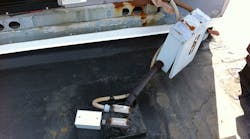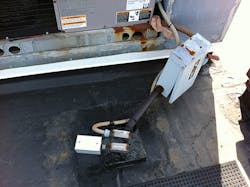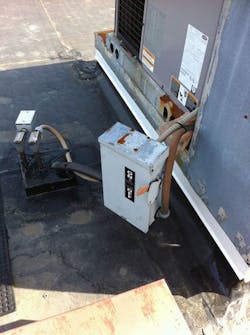How well do you know the Code? Think you can spot violations the original installer either ignored or couldn't identify? Here's your chance to moonlight as an electrical inspector and second-guess someone else's work from the safety of your living room or office. It's your turn to identify the violation.
Hint: An up-in-the-air handler switch
Find the Answer
The only thing supporting this disconnect switch is the liquidtight flexible metallic conduit (LFMC) and the wires connected to it. Section 300.11(A) requires raceways, boxes, and cabinets to be securely fastened in place. None of this equipment is fastened in place. It is all just free-floating and flopping around on the rooftop.
LFMC is not designed or intended to be used for supporting equipment such as this disconnecting means. Using it for this purpose violates the intent of Sec. 352.12(1) because the strain and extra weight on the raceway could cause damage to the raceway. It is also a violation of Sec. 110.3(B) because it is not designed or listed for this type of support.
I am also not sure how weatherproof this switch is because it seems to be tilted slightly forward, which could possibly allow rain to enter through the mounting holes on the back of the switch. This may violate the intent of Secs. 404.4(A) and 312.2 because moisture and water are likely to enter the enclosure.






